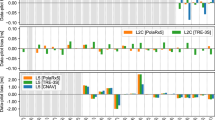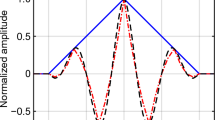Abstract
The world of global navigation satellite systems has been enhanced with several new or improved signals in space aiming to optimize accuracy, reliability, navigation solution, and interoperability between different constellations. However, such developments bring various challenges to the receivers’ designers. For example, acquisition and tracking stages turn into more complex processes while handling the increasing bandwidth requires additional processing power. In this context, we study the code tracking of Galileo E5ab in a full band or of only one of its components, i.e., either E5a or E5b. More specifically, an architecture for tracking the E5 pilot channel as an AltBOC(15,10) or BPSK(10) modulation is introduced, and the performance of well-known discriminator types is analyzed using analytical derivations and simulations of linearity and stability regions, thermal noise tracking errors, multipath error envelopes and tracking thresholds. Different parameters, such as the front-end filter bandwidth, the early/late chip spacing, un-normalized and normalized discriminators, are taken into consideration. The results obtained are used to illustrate the main advantages and drawbacks of tracking the E5 signal as well as to help defining the main tracking loop parameters for an enhanced performance.




















Similar content being viewed by others
References
Avila-Rodriguez JA (2008) On generalized signal waveforms for satellite navigation. PhD Thesis, University FAF Munich, Faculty of Aerospace Engineering, Munich, Germany
Betz J (2000) Design and performance of code tracking for the GPS M code signal. In: Proceedings of the 13th international technical meeting of the satellite division of the institute of navigation (ION GPS 2000), Salt Lake City, UT, pp 2140–2150, September 2000
Betz J, Kolodziejski K (2000) Extended theory of early-late code tracking for a bandlimited GPS receiver. Navig J 47(3):211–226
Braasch M, Dierendonck J (1999) GPS receiver architectures and measurements. Proc IEEE 87(1):48–64
European Space Agency, European Commission (2010) Galileo open service signal in space interface control document GAL OS SIS ICD issue 1
Gerein N (2005) Hardware architecture for processing Galileo alternate binary offset carrier (Altboc) signals. US Patent App. 10/681, 689
Jovanovic A, Tawk Y, Botteron C, Farine PA (2010) Multipath mitigation techniques for CBOC, TMBOC and AltBOC signals using advanced correlator architectures. In: Proceedings of IEEE/ION position location and navigation symposium PLANS 2010, Indian Wells/Palm Springs, California, USA, pp 1127–1136
Julien O (2005) Design of Galileo L1F receiver tracking loops. PhD Thesis, published as UCGE report no. 20227, Department of Geomatics Engineering, The University of Calgary
Kaplan E, Hegarty C (2006) Understanding GPS principles and applications. Artech House, ISBN 1-58053-894-0
Lestarquit L, Artaud G, Issler J.L (2008) AltBOC for dummies or everything you always wanted to know about AltBOC. In: Proceedings of the 21st international technical meeting of the satellite division of the institute of navigation (ION GNSS 2008), Savannah, GA, pp 961–970, September 2008
Margaria D, Dovis F, Mulassano P (2007) An innovative data demodulation technique for Galileo AltBOC receivers. J Global Position Systems 6(1):89–96
Ries L, Lestarquit L, Armengou-Miret E, Legrand F, Vigneau W, Bourga C, Erhard P, Issler JL (2002) A software simulation tool for GNSS2 BOC signals analysis. In: Proceedings of the 15th international technical meeting of the satellite division of the institute of navigation (ION GPS 2002), Portland, OR, pp 2225–2239, September 2002
Shivaramaiah NC (2009) Code phase multipath mitigation by exploiting the frequency diversity in Galileo E5 AltBOC. In: Proceedings of the 22nd international technical meeting of the satellite division of the institute of navigation (ION GNSS 2009), Savannah, GA, pp 3219–3233, September 2009
Shivaramaiah NC, Dempster AG (2009) The Galileo E5 AltBOC: understanding the signal. In: Proceedings of the international global navigation satellite systems society IGNSS symposium 2009, Queensland, Australia
Shivaramaiah NC, Dempster AG, Rizos C (2009) Hybrid tracking loop architectures for the Galileo E5 signal. In: Proceedings of the European navigation conference on global navigation satellite systems ENC GNSS 2009, Napoli, Italy
Sleewaegen JM, De Wilde W, Hollreiser M (2004) Galileo AltBOC receiver. In: Proceedings of the European navigation conference on global navigation satellite systems ENC GNSS 2004, Rotterdam, Netherlands
Spirent (2008) GSS8000 multi-GNSS constellation simulator. www.spirent.com/Solutions-Directory/GSS8000.aspx
Tawk Y, Jovanovic A, Botteron C, Farine PA (2010) Performance comparison of different correlation techniques for the AltBOC modulation in multipath environments. In: Proceedings of IEEE international conference on communications ICC 2010, Cape Town, South Africa. doi: 10.1109/ICC.2010.5502625
Acknowledgments
The authors are grateful for the financial support from the Swiss National Science Foundation (http://www.snf.ch/) who supports this work under grant 200021120187/1.
Author information
Authors and Affiliations
Corresponding author
Rights and permissions
About this article
Cite this article
Tawk, Y., Botteron, C., Jovanovic, A. et al. Analysis of Galileo E5 and E5ab code tracking. GPS Solut 16, 243–258 (2012). https://doi.org/10.1007/s10291-011-0226-8
Received:
Accepted:
Published:
Issue Date:
DOI: https://doi.org/10.1007/s10291-011-0226-8




